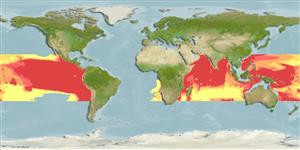>
Myctophiformes (Lanternfishes) >
Myctophidae (Lanternfishes) > Myctophinae
Etymology: Myctophum: Greek, mykter, -eros = nose + Greek, ophis = serpent (Ref. 45335).
More on author: Garman.
Environment: milieu / climate zone / depth range / distribution range
Écologie
marin bathypélagique; océanodrome (Ref. 51243). Deep-water; 25°N - 31°S
Western Indian Ocean: Gulf of Aden to Sofala Bank; Agulhas Current south to about 31°S. Eastern Indian Ocean: Indonesia to northwestern Australia (5°N-18°S). Western Pacific: southeast Asian seas. Eastern Pacific: Hawaii (Ref. 58302) and Panama to 04°15'S, 83°37'W of Peru (Ref. 5530); with more northerly distribution starting at 25°N (Ref. 31442). This fish comes from Xisha Islands and Zhongsha Islands of the South China Sea (Ref.74511).
Taille / Poids / Âge
Maturity: Lm ? range ? - ? cm
Max length : 11.0 cm SL mâle / non sexé; (Ref. 559)
Épines dorsales (Total): 0; Rayons mous dorsaux (Total): 9-14; Épines anales 0; Rayons mous anaux: 21 - 27; Vertèbres: 42 - 46. Anal organs 17; supracaudal gland of males with 6-9 triangular, overlapping scales; infracaudal gland of females with 3-7 rounded, usually contiguous luminous scales (Ref. 39633).
Neustonic (Ref. 58302). High-oceanic and mesopelagic. Found from the surface to 300 m at night (Ref. 4066). Oviparous, with planktonic eggs and larvae (Ref. 31442).
Life cycle and mating behavior
Maturité | Reproduction | Frai | Œufs | Fécondité | Larves
Hulley, P.A., 1986. Myctophidae. p. 282-321. In M.M. Smith and P.C. Heemstra (eds.) Smiths' sea fishes. Springer-Verlag, Berlin. (Ref. 4066)
Statut dans la liste rouge de l'IUCN (Ref. 130435)
Menace pour l'homme
Harmless
Utilisations par l'homme
Plus d'informations
RéférencesAquacultureProfil d'aquacultureSouchesGénétiqueElectrophoresesHéritabilitéPathologiesTraitementNutrientsMass conversion
Outils
Articles particuliers
Télécharger en XML
Sources Internet
Estimates based on models
Preferred temperature (Ref.
123201): 2.2 - 4.5, mean 2.7 °C (based on 1589 cells).
Phylogenetic diversity index (Ref.
82804): PD
50 = 0.5000 [Uniqueness, from 0.5 = low to 2.0 = high].
Bayesian length-weight: a=0.00692 (0.00297 - 0.01609), b=3.13 (2.93 - 3.33), in cm total length, based on LWR estimates for this (Sub)family-body shape (Ref.
93245).
Niveau trophique (Ref.
69278): 3.5 ±0.47 se; based on food items.
Résilience (Ref.
120179): Milieu, temps minimum de doublement de population : 1,4 à 4,4 années (Preliminary K or Fecundity.).
Fishing Vulnerability (Ref.
59153): Low vulnerability (10 of 100).
